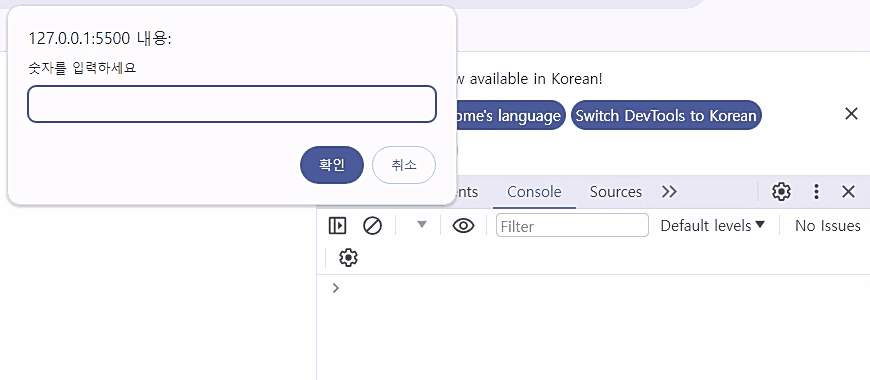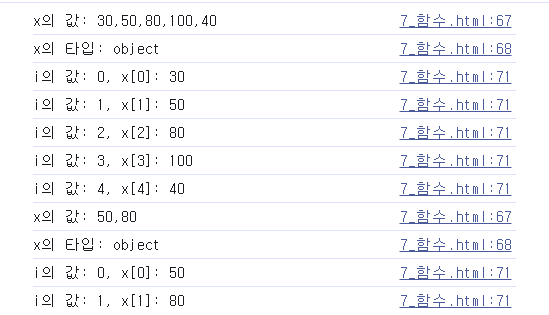제어문
조건문
- if 문
# 사용 방법
if(조건식){
조건식의 결과가 true일 때 실행할 문장;
...
}
--------------------------------------------
if(조건식){
조건식의 결과가 true일 때 실행할 문장;
...
}else{
조건식의 결과가 false일 때 실행할 문장;
}
---------------------------------------------
if(조건식1){
조건식1의 결과가 true일 때 실행할 문장;
...
}else if(조건식2){
조건식2의 결과가 true일 때 실행할 문장;
...
}else{
모든 조건식의 결과가 false일 때 실행할 문장;
...
}<!DOCTYPE html>
<html lang="en">
<head>
<meta charset="UTF-8">
<meta name="viewport" content="width=device-width, initial-scale=1.0">
<title>if 문</title>
</head>
<body>
<h2>if 문</h2>
<script>
const age = Number(prompt("나이를 입력하세요"));
if(age > 19){
console.log("성인입니다.");
}else if(age > 14){
console.log("청소년입니다.")
}else if(age > 6){
console.log("어린이입니다.")
}else{
console.log("유아입니다.")
}
</script>
</body>
</html>
- switch 문
# 사용 방법
switch(변수 또는 값) {
case 값1:
변수와 값1이 같은 경우 실행할 문장;
...
break;
case 값2:
변수와 값2가 같은 경우 실행할 문장;
...
break;
...
default:
변수와 모든 값이 다를 경우 실행할 문장;
...
}<!DOCTYPE html>
<html lang="en">
<head>
<meta charset="UTF-8">
<meta name="viewport" content="width=device-width, initial-scale=1.0">
<title>switch 문</title>
</head>
<body>
<h2>switch 문</h2>
<script>
let input = prompt("아동, 청소년, 성인 중 하나를 고르세요.");
switch(input){
case "아동":
input += ": 입장료 무료";
break;
case "청소년":
input += ": 입장료 5,000원";
break;
case "성인":
input += ": 입장료 10,000원";
break;
default:
alert("입력값을 확인하세요!");
input = "입력값 확인";
}
console.log(input);
</script>
</body>
</html>
반복문
- while 문
# 사용 방법
while(조건식) {
조건식의 결과가 true인 동안 반복할 문장;
...
}
-------------------------------------------
do {
조건식의 결과가 true인 동안 반복할 문장;
...
}while(조건식);
- do ~ while 문은 조건식의 결과가 처음부터 false인 경우라도 한 번은 {}의 문장을 실행함<!DOCTYPE html>
<html lang="en">
<head>
<meta charset="UTF-8">
<meta name="viewport" content="width=device-width, initial-scale=1.0">
<title>while 문</title>
</head>
<body>
<h2>while 문</h2>
<script>
while(true) {
let num = Number(prompt("숫자를 입력하세요"));
if (num % 2 == 0) {
console.log("짝수입니다. 프로그램을 종료합니다.");
break;
};
console.log("홀수입니다. 계속 진행하세요");
}
</script>
</body>
</html>
- for 문
# 사용 방법
for(초기값; 조건식; 증감식;) {
조건식의 결과가 true인 동안 반복할 문장;
...
}
------------------------------------------
for문의 무한루프
for(;;) {
...
}<!DOCTYPE html>
<html lang="en">
<head>
<meta charset="UTF-8">
<meta name="viewport" content="width=device-width, initial-scale=1.0">
<title>for 문</title>
</head>
<body>
<h2>for 문</h2>
<script>
for(let i=1; i<=100; i++) {
console.log(i);
};
</script>
</body>
</html>
- break 문
- switch 문 또는 반복(while, for)중인 루프 내에서 사용하여 해당 문장을 완전히 종료시키고 다음에 위치한 실행문으로 이동한다.(while 문 예제 참고)
- continue 문
- 반복중인 루프 내에서 사용하여 해당 루프의 나머지 부분을 건너뛰고 다음 반복문의 실행으로 넘어간다.
# 사용 방법
let num = 값;
while(num <= 값) {
console.log(num);
num++;
if (num == 특정값) continue;
...
...
}<!DOCTYPE html>
<html lang="en">
<head>
<meta charset="UTF-8">
<meta name="viewport" content="width=device-width, initial-scale=1.0">
<title>for 문</title>
</head>
<body>
<h2>for 문</h2>
<script>
for(let i=1; i<=100; i++) {
if (i % 3 == 0) {
console.log('😀');
continue;
};
console.log(i);
};
</script>
</body>
</html>
배열
배열(Array)
- 이름과 인덱스로 참조되는 정렬된 값의 집합이다.(자료구조)
- 배열을 구성하는 각각의 값을 배열요소라고 하며, 배열에서의 위치를 가리키는 숫자를 인덱스라고 한다.
# 사용 방법
- 배열 선언
let 변수명;
- 배열 초기화
변수명 = [요소1, 요소2, 요소3 ...];
let arr;
arr = [100, 200, 300];
- 배열 생성 함수
let 변수명 = Array(요소1, 요소2, 요소3 ...);
- 배열의 접근
let arr = [100, 200, 300];
arr[0] // 100
arr[1] // 200
arr[2] // 300
자바스크립트 배열의 특징
- 배열 요소의 타입이 고정되어 있지 않다.
ex)
let arr = [1, 1.5, '김사과', true]
- 배열 요소의 인덱스가 연속적이지 않아도 된다.
ex)
let arr;
arr[0] = 1;
arr[1] = 100;
arr[4] = 10;
// index 2, 3은 undefined
<!DOCTYPE html>
<html lang="en">
<head>
<meta charset="UTF-8">
<meta name="viewport" content="width=device-width, initial-scale=1.0">
<title>배열 1</title>
</head>
<body>
<h2>배열 1</h2>
<script>
const user = [1, "apple", "김사과", 20, "서울 서초구"];
console.log(user);
console.log(user[0]);
console.log(user[1]);
console.log(user[2]);
console.log(user[3]);
console.log(user[4]);
console.log(user[5]);
user[4] = "서울 강남구";
console.log(user[4]);
console.log(user.length);
console.log('----------------');
for(let i=0; i<user.length; i++) {
console.log(user[i]);
};
</script>
</body>
</html>
- 인덱스가 넘어가면 에러가 나지 않고 undefined으로 나온다.
- 인덱스 값을 바꿀 때, 인덱스 값을 새로 주면 된다.
- length를 이용하여 길이를 확인할 수 있다.
배열의 속성
- push() : 배열의 요소를 추가한다.
<!DOCTYPE html>
<html lang="en">
<head>
<meta charset="UTF-8">
<meta name="viewport" content="width=device-width, initial-scale=1.0">
<title>배열 2</title>
</head>
<body>
<h2>배열 2</h2>
<script>
const user = [1, "javascript", "자바스크립트", 20, "서울 송파구"];
user.push('자바'); # push() : 배열의 요소를 추가
console.log(user);
</script>
</body>
</html>
- pop() : 배열의 마지막 인덱스 번호에 있는 값을 제거한다.
<!DOCTYPE html>
<html lang="en">
<head>
<meta charset="UTF-8">
<meta name="viewport" content="width=device-width, initial-scale=1.0">
<title>배열 2</title>
</head>
<body>
<h2>배열 2</h2>
<script>
const user = [1, "javascript", "자바스크립트", 20, "서울 송파구"];
let temp = user.pop(); # pop() : 배열의 마지막 인덱스 번호에 있는 값을 제거
console.log(user);
console.log(temp);
</script>
</body>
</html>
- shift() : 배열의 첫 번째 인덱스 번호에 있는 값을 제거한다.
<!DOCTYPE html>
<html lang="en">
<head>
<meta charset="UTF-8">
<meta name="viewport" content="width=device-width, initial-scale=1.0">
<title>배열 2</title>
</head>
<body>
<h2>배열 2</h2>
<script>
const user = [1, "javascript", "자바스크립트", 20, "서울 송파구"];
console.log(user);
temp = user.shift(); # shift() : 배열의 첫 번째 인덱스 번호에 있는 값을 제거
console.log(user);
console.log(temp);
</script>
</body>
</html>
- concat() : 두 배열의 요소를 합친다.
<!DOCTYPE html>
<html lang="en">
<head>
<meta charset="UTF-8">
<meta name="viewport" content="width=device-width, initial-scale=1.0">
<title>배열 2</title>
</head>
<body>
<h2>배열 2</h2>
<script>
const user = [1, "javascript", "자바스크립트", 20, "서울 송파구"];
const profile = ["자바", "A형", "istp"]
result = user.concat(profile); # concat() : 두 배열의 요소를 합침
console.log(result);
</script>
</body>
</html>
- join() : 배열 요소 사이에 원하는 문자를 삽입한다.
<!DOCTYPE html>
<html lang="en">
<head>
<meta charset="UTF-8">
<meta name="viewport" content="width=device-width, initial-scale=1.0">
<title>배열 2</title>
</head>
<body>
<h2>배열 2</h2>
<script>
const user = [1, "javascript", "자바스크립트", 20, "서울 송파구"];
result = user.join('😀'); # join() : 배열 요소 사이에 원하는 문자를 삽입
console.log(result);
console.log(typeof(user));
console.log(typeof(result));
</script>
</body>
</html>
- sort() : 배열의 요소를 오름차순으로 나열한다.
<!DOCTYPE html>
<html lang="en">
<head>
<meta charset="UTF-8">
<meta name="viewport" content="width=device-width, initial-scale=1.0">
<title>배열 2</title>
</head>
<body>
<h2>배열 2</h2>
<script>
const arr = ['a', 'z', 'c', 'f', 'r'];
arr.sort(); # sort() : 배열의 요소를 오름차순
console.log(arr);
</script>
</body>
</html>
- reverse() : 배열의 요소를 역순으로 배치한다.
<!DOCTYPE html>
<html lang="en">
<head>
<meta charset="UTF-8">
<meta name="viewport" content="width=device-width, initial-scale=1.0">
<title>배열 2</title>
</head>
<body>
<h2>배열 2</h2>
<script>
const arr = ['a', 'z', 'c', 'f', 'r'];
arr.reverse(); # reverse() : 배열을 역순으로 재배치
console.log(arr);
</script>
</body>
</html>
배열을 이용한 반복
const arr = [10, 20, 30];
const user = [userid:"javascript", name:"자바스크립트", age:20];- for in 문
- 변수에 배열 인덱스 또는 객체의 key가 저장되며 반복한다.
<!DOCTYPE html>
<html lang="en">
<head>
<meta charset="UTF-8">
<meta name="viewport" content="width=device-width, initial-scale=1.0">
<title>배열 3</title>
</head>
<body>
<h2>배열 3</h2>
<script>
const userArray = [1, 'javascript', '자바스크립트', 20, '서울 송파구'];
const userObj = {userid:'javascript', name:'자바스크립트', age:20};
# for in 배열
for(let i in userArray) {
console.log(`i:${i}, userArr[${i}]: ${userArray[i]}`);
};
# for in 객체
for(let i in userObj) {
console.log(`i:${i}, userObj[${i}]: ${userObj[i]}`);
};
</script>
</body>
</html>

- for of 문
- 변수에 배열 value가 저장되며 반복한다.
<!DOCTYPE html>
<html lang="en">
<head>
<meta charset="UTF-8">
<meta name="viewport" content="width=device-width, initial-scale=1.0">
<title>배열 3</title>
</head>
<body>
<h2>배열 3</h2>
<script>
const userArray = [1, 'javascript', '자바스크립트', 20, '서울 송파구'];
const userObj = {userid:'javascript', name:'자바스크립트', age:20};
# for of 배열
for(let v of userArray) {
console.log(`v:${v}`);
};
</script>
</body>
</html>
- forEach 문
- 배열에서만 사용가능하며 요소의 개수만큼 반복한다.
<!DOCTYPE html>
<html lang="en">
<head>
<meta charset="UTF-8">
<meta name="viewport" content="width=device-width, initial-scale=1.0">
<title>배열 3</title>
</head>
<body>
<h2>배열 3</h2>
<script>
const userArray = [1, 'javascript', '자바스크립트', 20, '서울 송파구'];
const userObj = {userid:'javascript', name:'자바스크립트', age:20};
userArray.forEach(function(v, i, arr){
console.log(`v:${v}, i:${i}, arr:${arr}`);
});
</script>
</body>
</html>
함수
사용자 정의 함수(function)
- 하나의 특별한 목적의 작업을 수행하도록 설계된 독립적인 블록으로, 필요할 때마다 해당 작업을 반복 수행할 수 있다.
- 코드를 재활용하기 위한 목적이 있다.
- 함수 선언식
# 사용 방법
function 함수명(매개변수1, 매개변수2, ..) {
함수가 호출되었을 때 실행할 문장;
...
return 값;
}<!DOCTYPE html>
<html lang="en">
<head>
<meta charset="UTF-8">
<meta name="viewport" content="width=device-width, initial-scale=1.0">
<title>함수</title>
</head>
<body>
<h2>함수</h2>
<script>
function func1() {
console.log(`func1() 호출!`);
}
func1();
func1();
</script>
</body>
</html>
- 함수 표현식
# 사용 방법
const 변수명 = function(매개변수1, 매개변수2, ..) {
함수가 호출되었을 때 실행할 문장;
...
return 값;
}<!DOCTYPE html>
<html lang="en">
<head>
<meta charset="UTF-8">
<meta name="viewport" content="width=device-width, initial-scale=1.0">
<title>함수</title>
</head>
<body>
<h2>함수</h2>
<script>
function func4(){
return '🍔';
}
func4();
console.log(func4());
const presents = func4();
console.log(presents);
</script>
</body>
</html>
- 디폴트 매개변수
- 매개변수의 값을 설정한다.
- 매개변수의 값을 정하지 않으면 기본값을 변수에 저장한다.
# 사용 방법
function 함수명(매개변수1=값1, 매개변수2=값2, ...) {
함수가 호출되었을 때 실행할 문장;
...
return 값;
}<!DOCTYPE html>
<html lang="en">
<head>
<meta charset="UTF-8">
<meta name="viewport" content="width=device-width, initial-scale=1.0">
<title>함수</title>
</head>
<body>
<h2>함수</h2>
<script>
function func5(num1=1, num2=1) {
console.log(`num1의 값: ${num1}, num2의 값: ${num2}`);
console.log(`${num1} * ${num2} = ${num1 * num2}`);
}
func5(10, 3);
func5(10);
func5();
</script>
</body>
</html>
- 나머지 매개변수
- 생략 접두사(...)를 사용하여 특정 위치의 인수부터 마지막 인수까지 한 번에 지정할 수 있다.
# 사용 방법
function 함수명(매개변수1, ...매개변수2) {
함수가 호출되었을 때 실행할 문장;
...
return 값;
}
# 들어가는 값 위치
함수명(값1, 값2, 값3, 값4);
매개변수1: 값1
매개변수2: 갑2, 값3, 값4<!DOCTYPE html>
<html lang="en">
<head>
<meta charset="UTF-8">
<meta name="viewport" content="width=device-width, initial-scale=1.0">
<title>함수</title>
</head>
<body>
<h2>함수</h2>
<script>
function func6(...x) {
console.log(`x의 값: ${x}`);
console.log(`x의 타입: ${typeof(x)}`);
for(i in x){
console.log(`i의 값: ${i}, x[${i}]: ${x[i]}`);
}
}
func6(30, 50, 80, 100, 40);
func6(50, 80);
</script>
</body>
</html>
호이스팅
- 인터프리터가 변수와 함수의 메모리 공간을 선언 전에 미리 할당하는 것이다.
- var로 선언한 변수의 경우 호이스팅 시 undefined로 변수를 초기화한다.
- let과 const로 선언한 변수의 경우 호이스팅 시 변수를 초기화하지 않는다.
화살표 함수
- function 키워드를 사용하여 함수를 만드는 것보다 간단하게 표현한다.
- 화살표 함수는 항상 익명이고, return은 생략하며, 모든 화살표 함수는 return형이다.
# 사용 방법
const 변수명 = function(){
...
} # 화살표 함수 사용하지 않은 모습
# 매개변수가 없는 경우
const 변수명 = () => {
...
}
const 변수명 = () => 문장;
# 매개변수가 있는 경우
const 변수명 = 매개변수1 => {
...
}
const 변수명 = (매개변수1, 매개변수2, ..) => {
...
}<!DOCTYPE html>
<html lang="en">
<head>
<meta charset="UTF-8">
<meta name="viewport" content="width=device-width, initial-scale=1.0">
<title>화살표 함수</title>
</head>
<body>
<h2>화살표 함수</h2>
<script>
const func1 = () => console.log("안녕하세요. 자바스크립트!");
func1();
console.log('-------------');
const func2 = x => x * x;
const result = func2(10);
console.log(`10의 제곱:${result}`);
const func3 = (x, y) => {
let sum = 0;
for(let i=x; i<=y; i++) {
sum += i;
}
return sum;
}
const total = func3(1, 100);
console.log(`1부터 100까지의 합: ${total}`);
console.log('-------------');
let age = Number(prompt("나이를 입력하세요"))
const isAdult = (age > 19) ? () => console.log("성인입니다.") : () => console.log("미성년입니다.");
isAdult();
</script>
</body>
</html>

객체
객체(Object)
- 하나의 주체를 가지고 관련있는 프로퍼티(Property)를 가지고 있는 집합이다.
프로퍼티(Property)
- 이름과 값으로 구성된 정렬되지 않은 집합이다.
- 프로퍼티 함수도 저장할 수 있다.(프로퍼티 메서드)
객체를 생성하는 방법
- 리터럴 표기법
# 사용 방법
const 변수명 = {
프로퍼티명1:값1,
프로퍼티명2:값2,
...
프로퍼티명n:function(){
...
}
}<!DOCTYPE html>
<html lang="en">
<head>
<meta charset="UTF-8">
<meta name="viewport" content="width=device-width, initial-scale=1.0">
<title>객체 만들기</title>
</head>
<body>
<h2>객체 만들기</h2>
<script>
// 리터럴 표기법
const Rucy = {
name: '루시',
age: 14,
color: 'white',
birthday: '20091210',
getBirthday: function() {
return this.birthday;
}
}
console.log(Rucy.name);
console.log(Rucy.age);
console.log(Rucy.color);
console.log(Rucy.birthday);
console.log(Rucy.getBirthday);
console.log(Rucy.getBirthday());
</script>
</body>
</html>
- 생성자를 이용한 표기법
- 객체를 만드는 함수이다.
- new 연산자를 사용하여 객체를 생성하고 초기화할 수 있다.
- 같은 형태의 객체를 여러개 생성할 때 좋다.
# 사용 방법
function 함수명(매개변수1, 매개변수2 ...) {
this.프로퍼티1 = 값1;
this.프로퍼티2 = 값2;
...
this.프로퍼티n = function(){
...
}
}
const 변수1 = new 함수명(값1, 값2, ...);
const 변수2 = new 함수명(값1, 값2, ...);<!DOCTYPE html>
<html lang="en">
<head>
<meta charset="UTF-8">
<meta name="viewport" content="width=device-width, initial-scale=1.0">
<title>객체 만들기</title>
</head>
<body>
<h2>객체 만들기</h2>
<script>
//생성자를 이용한 객체
function Dog(name, color) {
this.name = name;
this.color = color;
this.eat = function() {
return `${this.name} 사료를 먹습니다.`;
}
}
const PPomi = new Dog('뽀미', '흰색');
console.log(PPomi.name);
console.log(PPomi.color);
console.log(PPomi.eat());
</script>
</body>
</html>
- 클래스를 이용한 표기법
- ECMA Script6에 추가된 객체 생성 방법으로 내부적으로 생성자를 이용한 객체 생성 방법과 동일하게 작동한다.
# 사용 방법
const 클래스명 = class {
constructor(매개변수1, 매개변수2, ...) {
this.프로퍼티1 = 값1,
this.프로퍼티2 = 값2,
...
}
메소드명(매개변수1, 매개변수2, ...) {
...
}
}
const 변수명1 = new 클래스명(값1, 값2, ...);
const 변수명2 = new 클래스명(값1, 값2, ...);<!DOCTYPE html>
<html lang="en">
<head>
<meta charset="UTF-8">
<meta name="viewport" content="width=device-width, initial-scale=1.0">
<title>객체 만들기</title>
</head>
<body>
<h2>객체 만들기</h2>
<script>
// 클래스를 이용한 객체 생성
const Student = class {
constructor(name, hp, age) {
this.name = name;
this.hp = hp;
this.age = age;
}
getName() {
return `이름은 ${this.name} 입니다.`;
}
}
const apple = new Student('김사과', '010-0000-0000', 20);
console.log(apple.name);
console.log(apple.hp);
console.log(apple.age);
console.log(apple.getName);
console.log(apple.getName());
</script>
</body>
</html>
프로토타입(Prototype)
- 모든 객체는 프로토타입이라는 객체를 가지고 있고, 프로토타입으로부터 프로퍼티와 프로퍼티 메서드를 상속받는다.
- 모든 객체는 최소한 하나 이상의 다른 객체로부터 상속을 받으며, 상속되는 정보를 제공하는 객체를 프로토타입이라고 한다.
# 예시
const animal = new Animal(); # Animal.prototype, Object.prototype<!DOCTYPE html>
<html lang="en">
<head>
<meta charset="UTF-8">
<meta name="viewport" content="width=device-width, initial-scale=1.0">
<title>프로토타입</title>
</head>
<body>
<h2>프로토타입</h2>
<script>
function Dog(color, name, age) {
this.color = color;
this.name = name;
this.age = age;
}
const Rucy = new Dog('흰색', '루시', 14);
console.log(Rucy);
console.log(`이름: ${Rucy.name}`);
console.log(`색상: ${Rucy.color}`);
console.log(`나이: ${Rucy.age}`);
Rucy.family = '포메라니안';
Rucy.getFamily = function() {
return this.family;
}
console.log(`종: ${Rucy.family}`);
console.log(`getfamily: ${Rucy.getFamily()}`);
const PPomi = new Dog('흰색', '뽀미', 6);
console.log(`이름: ${PPomi.name}`);
console.log(`색상: ${PPomi.color}`);
console.log(`나이: ${PPomi.age}`);
console.log(`종: ${PPomi.family}`);
// console.log(`getfamily: ${PPomi.getFamily()}`);
Dog.prototype.owner = '김사과';
Dog.prototype.run = function() {
return this.name + ' 달립니다.';
}
console.log(`Rucy 소유자: ${Rucy.owner}`);
console.log(`PPomi 소유자: ${PPomi.owner}`);
console.log(`Rucy run(): ${Rucy.run()}`);
console.log(`PPomi run(): ${PPomi.run()}`);
</script>
</body>
</html>
Math 객체
- min() : 가장 작은 수를 반환한다. 매개변수가 전달되지 않으면 Infinity를 반환한다.
<!DOCTYPE html>
<html lang="en">
<head>
<meta charset="UTF-8">
<meta name="viewport" content="width=device-width, initial-scale=1.0">
<title>Math 객체</title>
</head>
<body>
<script>
# min() : 가장 작은 수를 반환. 매개변수가 전달되지 않으면 infinity를 반환
console.log(Math.min());
console.log(Math.min(1, 10, -10, 1000, 0, '-100'));
console.log(Math.min(1, 10, -10, '마이너스천', 0, '-100'));
</script>
</body>
</html>
- max() : 가장 큰 수를 반환한다. 매개변수가 전달되지 않으면 -Infinity를 반환한다.
<!DOCTYPE html>
<html lang="en">
<head>
<meta charset="UTF-8">
<meta name="viewport" content="width=device-width, initial-scale=1.0">
<title>Math 객체</title>
</head>
<body>
<script>
# max() : 가장 큰 수를 반환. 매개변수가 전달되지 않으면 -Infinity를 반환
console.log(Math.max());
console.log(Math.max(1, 10, -10, 1000, 0, '-100'));
console.log(Math.max(1, 10, -10, '마이너스천', 0, '-100'));
</script>
</body>
</html>
- round() : 소수점 첫 번째 자리에서 반올림하여 그 결과를 반환한다.
<!DOCTYPE html>
<html lang="en">
<head>
<meta charset="UTF-8">
<meta name="viewport" content="width=device-width, initial-scale=1.0">
<title>Math 객체</title>
</head>
<body>
<script>
# round() : 소수점 첫 번째 자리에서 반올림하여 그 결과를 반환
console.log(Math.round(10.49));
console.log(Math.round(10.5));
console.log(Math.round(-10.5));
console.log(Math.round(-10.51));
</script>
</body>
</html>
- floor() : 소수점을 버림 하여 그 결과를 반환한다.
<!DOCTYPE html>
<html lang="en">
<head>
<meta charset="UTF-8">
<meta name="viewport" content="width=device-width, initial-scale=1.0">
<title>Math 객체</title>
</head>
<body>
<script>
# floor() : 소수점을 버림
console.log(Math.floor(10.49));
console.log(Math.floor(10.5));
console.log(Math.floor(-10.5));
console.log(Math.floor(-10.51));
</script>
</body>
</html>
- ceil() : 소수점 첫 번째 자리에서 소수점을 올림 하여 그 결과를 반환한다.
<!DOCTYPE html>
<html lang="en">
<head>
<meta charset="UTF-8">
<meta name="viewport" content="width=device-width, initial-scale=1.0">
<title>Math 객체</title>
</head>
<body>
<script>
# ceil() : 소수점 첫 번째 자리에서 소수점을 올림
console.log(Math.ceil(10.49));
console.log(Math.ceil(10.5));
console.log(Math.ceil(-10.5));
console.log(Math.ceil(-10.51));
</script>
</body>
</html>
- random() : 0보다 크거나 같고 1보다 작은 무작위 소수를 반환한다.
<!DOCTYPE html>
<html lang="en">
<head>
<meta charset="UTF-8">
<meta name="viewport" content="width=device-width, initial-scale=1.0">
<title>Math 객체</title>
</head>
<body>
<script>
# random() : 0보다 크거나 같고 1보다 작은 무작위 소수를 반환
const ram = Math.random();
console.log(ram);
const number = Math.ceil(Math.random() * 10);
console.log(number);
</script>
</body>
</html>
상속
- 클래스 기반의 객체지향 언어와 다르다. 자바스크립트는 프로토 타입 기반의 객체지향 언어이다.
문제
가위바위보 게임 만들기
| 게임 방식 가위, 바위, 보 중 하나를 입력하세요. 가위 컴퓨터: 바위, 유저: 가위 -> 패 가위, 바위, 보 중 하나를 입력하세요. 바위 컴퓨터: 가위, 유저: 바위 -> 승 |
<!DOCTYPE html>
<html lang="en">
<head>
<meta charset="UTF-8">
<meta name="viewport" content="width=device-width, initial-scale=1.0">
<title>가위바위보 게임</title>
</head>
<body>
<h2>가위바위보 게임</h2>
<script>
let computer;
const number = Math.ceil(Math.random() * 10);
if (number > 6){
computer = '가위';
}
else if(number <= 6){
computer = '바위';
}
else if(number < 3){
computer = '보'
}
for(;;){
let str = prompt("가위, 바위, 보 중 하나를 입력하세요");
if (str == computer){
console.log(`컴퓨터: ${computer}, 유저: ${str} -> 비겼습니다.`)
}
else if((str == '가위' && computer == '바위') || (str == '바위' && computer == '보') || (str == '보' && computer == '가위')){
console.log(`컴퓨터: ${computer}, 유저: ${str} -> 유저 패`)
}
else{
console.log(`컴퓨터: ${computer}, 유저: ${str} -> 유저 승.`)
break;
}
}
console.log("프로그램을 종료합니다.")
</script>
</body>
</html>
<!DOCTYPE html>
<html lang="en">
<head>
<meta charset="UTF-8">
<meta name="viewport" content="width=device-width, initial-scale=1.0">
<title>가위바위보 게임</title>
</head>
<body>
<h2>가위바위보 게임</h2>
<script>
while(true){
const com = Math.ceil(Math.random()*3);
user = prompt("가위바위보 중 하나를 입력하세요");
if(user == '가위'){
if(com == 1){
console.log("컴퓨터: 가위, 유저: 가위 -> 비겼습니다.");
}else if(com == 2){
console.log("컴퓨터: 바위, 유저: 가위 -> 졌습니다.");
}else if(com == 3){
console.log("컴퓨터: 보, 유저: 가위 -> 이겼습니다.");
break;
}
}else if(user == '바위'){
if(com == 1){
console.log("컴퓨터: 가위, 유저: 바위 -> 이겼습니다.");
break;
}else if(com == 2){
console.log("컴퓨터: 바위, 유저: 바위 -> 비겼습니다.");
}else if(com == 3){
console.log("컴퓨터: 보, 유저: 바위 -> 졌습니다.");
}
}else if(user == '보'){
if(com == 1){
console.log("컴퓨터: 가위, 유저: 보 -> 졌습니다.");
}else if(com == 2){
console.log("컴퓨터: 바위, 유저: 보 -> 이겼습니다.");
break;
}else if(com == 3){
console.log("컴퓨터: 보, 유저: 보 -> 비겼습니다.");
}
}
}
console.log("프로그램을 종료합니다.")
</script>
</body>
</html>
로또번호 뽑기 프로그램 만들기
<!DOCTYPE html>
<html lang="en">
<head>
<meta charset="UTF-8">
<meta name="viewport" content="width=device-width, initial-scale=1.0">
<title>로또번호</title>
</head>
<body>
<h2>로또번호</h2>
<script>
const lotto = [0, 0, 0, 0, 0, 0];
for(let i=0; i<lotto.length; i++){
lotto[i] = Math.ceil(Math.random() * 45);
for(let j=0; j<i; j++){
if(lotto[i] == lotto[j]){
i--;
}
}
}
lotto.sort(function(p, c){return p-c})
console.log(lotto);
</script>
</body>
</html>
'Web > javascript' 카테고리의 다른 글
| Node.js buffer, stream, pipe (0) | 2024.04.25 |
|---|---|
| Node.js (비)동기, Promise, JSON, fetch, module, import... 등 (0) | 2024.04.23 |
| Node.js 이터레이터, 이터러블, 스프레드 연산자 (0) | 2024.04.23 |
| JavaScript 정규표현식, 이벤트 (1) | 2024.04.22 |
| JavaScript 변수, 데이터 타입, 타입변환 함수, 연산자 (1) | 2024.04.15 |